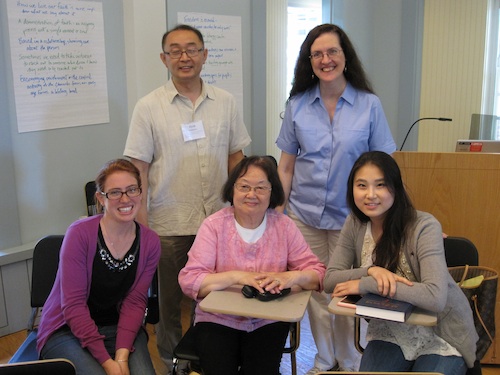
“For young and for old, a place at the table”[1]: Culturally-Conscious Weekly Communion for Every Generation
by Emilie Coakley
“I was saturated with the self-giving love of God,” lay leader Hai Lanne Hahm told us on a June afternoon in the ISM great hall, as she reflected on the importance of her congregation’s celebration of Holy Communion every Sunday. This path to a “culturally conscious weekly communion” has been a deliberately long road for the community of Zion Korean United Methodist Church (UMC), in Warwick, Rhode Island. Responding to a growing generational, cultural, and linguistic divide in this changing Korean American congregation, Rev. Hyuk Seonwoo turned to the Eucharistic table and a practice of weekly Communion to bridge this deepening chasm of difference.
Deeply connected to the call, work, and mission of Jesus Christ, Rev. Seonwoo has led his congregation in a 14-year discernment process of reclaiming the table of the Word and the table of the Meal. Their bilingual weekly Communion service—a change from and much more frequent than the community’s previous practice and cultural norm—has served as a conduit for inviting the youth into the sanctuary and service, elements of community life from which they had previously seemed alienated. The stakes are high to try to involve the youth while they are still at church with their families. The facts are sobering: as sociologist Karen Chai explains, “according to some estimates, 90 percent of post-college Korean Americans are no longer attending church.”[2]
In response to this “Silent Exodus,” Rev. Seonwoo and the Zion Korean UMC church have intentionally implemented programs that extend agency to the congregation’s youth, while working to achieve greater generational cohesion in their community. Hinged on an intergenerational summer retreat—which includes Holy Communion, bread baking, and an agape love feast—this congregation’s generationally inclusive mission echoes the sentiments of Matthew 6:33, to “seek first [God’s] kingdom and his righteousness” (Matthew 6: 33, NIV). This active in-breaking works to project a vision of the Kingdom of God that connects elders with the youth in the community, as all work toward discipleship and a new life of holiness in Jesus Christ. At the same time, the Communion celebration is an anticipation of the great banquet of eternity[3] in the Heavenly Kingdom, where neither age nor language will bar God’s people from the celestial feast.
The importance of inculturated worship as the first step towards respecting others and embracing the way of God is forefront in this community’s liturgical, musical, and pedagogical practices. Korean cultural identity is invoked in a manner that expands the younger generation’s current cultural reality through sound, sign, language, and symbol. From a young age, children are surrounded by images of their community’s cultural memory. The nursery room is decorated with murals of Korean Folktales and Bible stories, providing a visual invitation for the children to better understand who they are in relation to their religious and cultural identity as Korean American Christians. Similarly, by having a traditional Korean drum present at every service and weekly singing Korean hymns during the communion procession, Korean culture is intoned in a way that encourages all generations to participate. As put forth in their congregation’s project statement, “music becomes an important common language among the generations” at Zion Korean UMC, where liturgical and musical leadership work to embrace their cultural roots while at the same time making worship accessible to young and older generations together.
The nexus of this community’s coming together as one body occurs in a bilingual celebration of Holy Communion, where both Korean and English are employed and all generations are invited to partake in the Eucharist together. In this sense, the sacrament of Holy Communion serves “as a sign act [that] dismantles the language barrier” between generations. Meaning is embodied, and not only spoken.
The gentle intentionality of Zion Korean UMC’s mission, as theologian and respondent Don Saliers explained, feeds a worship life and a community life that are mutually supporting. Gently holding truths in tension is both a physical and theological process for this congregation, as a group gathers every Saturday to do Tai Chi together and reflect on the Christological implications of this embodied practice. Referring to the trifold concept embedded in the “loosen empty push” of kinetic and potential energy within Tai Chi, Rev. Seonwoo casts this “rhythm of creation” in light of the life, death, and resurrection of Jesus Christ.
Dying and rising with Christ is centered around the Communion table at Zion Korean UMC, as the Eucharistic feast begins to enact the kingdom of Heaven on earth. Culturally contextualized weekly Holy Communion has become an intergenerational incarnational reality, embodying the eternal hopes of John 6:51, where “if anyone eats of this bread, he will live forever.”[4] The intergenerational cohesion for Rev. Seonwoo and his congregation is nothing less than the Body and Blood of Jesus Christ, celebrating “the living bread that came down from heaven”[5] weekly through a Holy Communion in which young and old alike have a place at the table and a home in the Kingdom.
[1]Lyrics by Shirley Erena Murray. 1996. From, “For everyone born, a place at the table.”
[2] Karen J. Chai. 1998. “Competing for the Second Generation: English-Language Ministry at a Korean Protestant Church,” in Stephen Warner and Judith G. Wittner’s Gatherings In Diaspora: Religious communities and the New Immigration. Philadelphia, PA: Temple University Press. 300.
[3] A concept alluded to in alluded to in Rita Ferrone’s opening remarks for the Zion UMC Congregational Project Session at the Yale ISM Congregations Project Summer Seminar, June 21, 2015.
[4] John 6:51, NIV.
[5] Ibid.